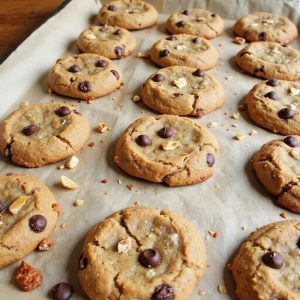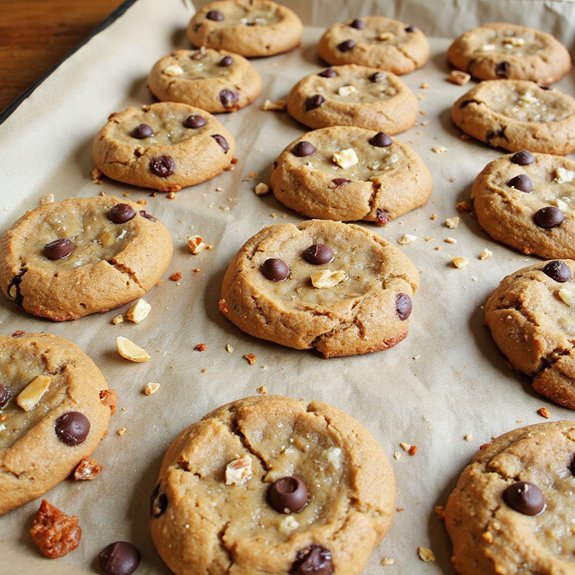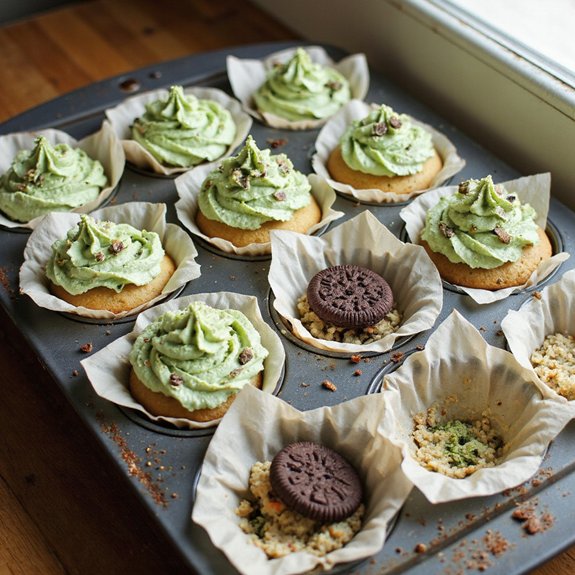Picture warm, caramel-amber butter swirling with the nutty aroma of toasted milk solids, meeting creamy peanut butter that turns the batter silky and plush.
Imagine bite-sized cookies with crackly sugared edges, soft fudgy centers, and just a whisper of sourdough tang—comfort you can smell before the oven timer dings.
This matters to me because brown butter takes a childhood favorite and gives it grown-up depth; one small tweak, and suddenly the house feels cozier.
These little bites shine anywhere: after-school treats, tucked into lunchboxes, sweet finishers for Sunday suppers, or a quick pick-me-up during busy weeknights when you want homemade without fuss.
Once, a rainy afternoon derailed our plans; a bowl, some discard, and 30 minutes later, a tray of warm peanut butter bites brought everyone to the table and the mood lifted instantly.
We’ll keep it simple, reliable, and delicious.
Ready? Let’s cook!
Why You’ll Love It
- Delivers bold flavor from nutty brown butter and roasted peanuts
- Uses sourdough discard for tenderness and subtle tang
- Mixes quickly; no chill beyond brief 30-minute rest
- Bakes small, snackable bites with fudgy centers
- Freezes beautifully; bake straight from frozen with ease
Ingredients
- 113 g unsalted butter — brown and cool until toasty and amber (real butter, not spread)
- 120 g creamy peanut butter — smooth, not natural (classic shelf-stable style)
- 100 g light brown sugar — packed (fresh, soft crystals)
- 60 g granulated sugar — standard white (fine texture dissolves well)
- 1 large egg — room temperature (for better emulsion)
- 1 tsp vanilla extract — pure, not imitation (clean flavor)
- 120 g sourdough discard — unfed, room temperature (moderate tang)
- 150 g all-purpose flour — standard protein (unbleached if possible)
- 1/2 tsp baking soda — fresh (check date for lift)
- 1/2 tsp baking powder — aluminum-free preferred (clean taste)
- 1/4 tsp fine sea salt — fine grain disperses evenly
- 60 g mini chocolate chips — optional (choose good melting chips)
- 30 g roasted peanuts, chopped — optional (salted for contrast)
- 30 g granulated sugar — optional, for rolling (crackly crust)
Step-by-Step Method
Brown the Butter
Melt butter over medium heat. Cook, swirling, until foamy and amber with toasty milk solids. Immediately scrape into a bowl, including browned bits. Cool until fluid but not hot to the touch. This guarantees melting the peanut butter and thinning the dough.
Set aside while you prepare the dry ingredients.
Combine Dry Ingredients
Whisk flour, baking soda, baking powder, and fine sea salt in a mixing bowl. Ensure the leaveners are evenly dispersed to promote uniform rise. Break up any flour clumps.
Set the bowl aside. Keeping dry and wet components separate until folding limits gluten development and preserves tenderness in the bites.
Cream Butter, Peanut Butter, and Sugars
Beat cooled brown butter, creamy peanut butter, light brown sugar, and granulated sugar until creamy and slightly lightened, about 2 minutes. Use a hand or stand mixer for best aeration.
Scrape the bowl and beater. Proper creaming dissolves sugars partially and creates a smooth, cohesive base that bakes up fudgy yet structured.
Add Egg and Vanilla
Crack in the room-temperature egg and pour in vanilla extract. Beat until the mixture looks smooth, glossy, and fully emulsified.
Stop and scrape the bowl to catch any streaks. A well-emulsified base supports even texture and prevents greasy spots. Don’t overbeat once it’s glossy and consistent.
Incorporate Sourdough Discard
Mix in the sourdough discard until fully combined and no streaks remain. Ensure your discard is at room temperature.
If it seems very thin, reserve a tablespoon or two to adjust later. The discard adds tenderness and a subtle tang while contributing hydration. Aim for a cohesive, scoopable batter.
Fold in Dry Ingredients
Switch to a rubber spatula. Add the dry mixture and fold gently just until no dry pockets remain. Avoid overmixing to limit gluten development.
If using, fold in mini chocolate chips and chopped roasted peanuts. The dough should feel soft, not sticky or greasy. Add a touch of flour only if needed.
Chill to Hydrate
Cover the bowl and refrigerate the dough for 30 minutes. Allow the flour to hydrate and the fats to firm slightly.
This rest improves scooping, reduces spread, and sharpens flavors. If the dough feels overly stiff after chilling, let it sit at room temperature for a few minutes before scooping.
Preheat and Prep Pans
Heat the oven to 350°F (175°C). Line two baking sheets with silicone baking mats or parchment. Position a rack in the center for even baking.
Prepare a small bowl with granulated sugar if rolling the dough balls. Set out a cookie scoop to portion neatly and maintain consistent sizes.
Portion and Roll
Scoop 1-tablespoon portions of dough. Roll each portion into a smooth ball between your palms.
For a crackly crust, toss balls in granulated sugar to coat lightly. Arrange on prepared sheets, spacing about 2 inches apart. Gently press to roughly 1/2 inch thickness to encourage even baking.
Bake to Just-Set
Bake one sheet at a time for 10–12 minutes. Watch for set edges and soft, slightly puffed centers.
Don’t overbake to maintain fudgy interiors. Rotate the sheet once if your oven has hot spots. Remove when the centers still look a touch underdone; they’ll finish setting on the sheet.
Cool and Finish
Let the bites cool on the sheet for 5 minutes to firm. Transfer to a wire rack to finish cooling.
Sprinkle a pinch of flaky salt on warm tops for contrast, if desired. For freezing, place scooped dough balls on a tray to harden, then bag. Bake from frozen at 350°F for 12–14 minutes.
Ingredient Swaps
- Butter: Use vegan butter or refined coconut oil (add a pinch of salt) for dairy-free; skip browning with coconut oil.
- Peanut butter: Swap with almond, cashew, or sunflower seed butter (nut-free) but add 1–2 tbsp extra flour if dough seems oily; avoid “natural” runny styles or chill longer.
- Egg: Replace with 1 flax egg (1 tbsp ground flax + 3 tbsp water, rested 10 min) or 3 tbsp aquafaba.
- Sourdough discard: Substitute with 60 g plain yogurt or buttermilk plus 60 g flour; or 120 g preferment from local starter style.
- Flour: Use a 1:1 gluten-free baking blend; if using oat flour, replace 25–30% and add 1–2 tsp milk if dough is stiff.
- Sugars: Light brown can be swapped with coconut sugar; granulated with caster or raw cane (grind coarse sugars).
- Mix-ins: Replace chocolate chips with chopped dark chocolate, cacao nibs, or dried fruit; peanuts with toasted seeds for nut-free.
- Rolling sugar: Use turbinado for extra crunch or skip for lower sugar.
You Must Know
Doneness • If edges look set but centers seem glossy and slightly domed, pull them now; carryover heat will finish them in 5–7 minutes on the sheet, yielding fudgy middles instead of drying out.
Troubleshoot • If the dough spreads thin within 6–8 minutes in the oven, chill shaped portions 15–20 minutes and add 10–15 g flour; warm butter/peanut butter or wetter discard causes over-spread.
Flavor Boost • For deeper nutty notes, toast the peanuts to a light amber (6–8 minutes at 350°F/175°C) and add 1/8 tsp espresso powder; boosts roasted flavors and rounds sweetness without tasting like coffee.
Swap • Using natural peanut butter? Stir until glossy with no oil rivulets, then add 10–20 g extra flour; prevents greasy texture and keeps a soft, scoopable dough.
Scale • For half or double batches, keep leavening proportional (1/4 tsp each soda and powder for half; 1 tsp each for double) and aim for the same dough feel: soft, holds a 1-tbsp scoop without slumping more than 2–3 mm in 30 seconds.
Serving Tips
- Serve warm with cold milk or a small glass of oat milk.
- Plate with sliced bananas and a drizzle of honey or warmed jam.
- Pair alongside vanilla ice cream and a sprinkle of flaky sea salt.
- Offer with coffee or hot cocoa; add a dusting of powdered sugar.
- Build a snack board with fresh berries, roasted peanuts, and dark chocolate squares.
Storage & Make-Ahead
Store baked bites airtight at room temperature 3–4 days or in the fridge up to 1 week; they soften slightly chilled.
For make-ahead, refrigerate dough up to 48 hours for deeper flavor.
Freeze dough balls or baked bites up to 2 months; bake frozen balls 12–14 minutes at 350°F.
Reheating
Reheat gently: microwave 5–10 seconds per bite.
Oven at 300°F (150°C) for 4–6 minutes.
Or stovetop in covered skillet on low 2–3 minutes.
Avoid overbaking; warmth revives fudgy centers.
Lunchbox Nostalgia Moment
Warm them gently and you’ll release that just-baked aroma—perfect for tucking into a lunchbox. I slide a few into a napkin-lined container, still a whisper warm, so the brown butter perfumes everything inside.
The peanutty sweetness feels like a throwback to cafeteria swaps and crinkly baggies, but the sourdough tang gives it a grown-up wink.
I tuck one beside crisp apple slices; the chocolate chips speckle like confetti, and the crackly sugar crust holds its bite. By noon, they’re soft-centered, edges set, ready for that first quiet break between classes or meetings.
I love how the roasted peanut crunch echoes the snap of the lunchbox latch. Pack two for a friend—or a future you—because nostalgia tastes better when shared.
Final Thoughts
Ready to bake a batch? Give these bites a try as written, then tweak to taste—swap in crunchy peanut butter, add a pinch of flaky salt, or stir in your favorite mix-ins to make them your own!
Frequently Asked Questions
Can I Make Them Gluten-Free Without Compromising Texture?
Yes—you can. I’d swap in a quality 1:1 gluten‑free flour with xanthan, add 10 g extra, and rest the dough 45 minutes. You’ll still get tender, fudgy centers, crisp edges, and that nutty, brown‑butter aroma.
How Do Altitude Adjustments Affect Baking Time and Spread?
At high altitude, I bake a bit longer and expect more spread. I add 1–2 tablespoons flour, reduce sugar slightly, and chill dough colder. I also raise oven temp 15°F for quicker set and thicker edges.
What’s the Best Way to Brown Butter Without Burning?
Keep heat medium, use a light-colored pan, and stir constantly. I watch foam subside, sniff for nuttiness, and pull it when milk solids turn deep amber. Immediately pour into a cool bowl to halt browning.
Can I Use a Cookie Press or Mini Muffin Tin?
Yes—you can. I’d use a mini muffin tin, lightly greased, filling each cup halfway; bake until edges set. A cookie press works too, but chill the dough firmer and test a small batch for definition.
How Do I Prevent Peanut Allergies While Keeping Flavor?
Use roasted sunflower seed butter and toasted seeds; I promise it delivers nutty aroma without peanuts. I’ll add vanilla, browned butter, and a pinch of flaky salt. Clearly label, avoid cross-contact, and use dedicated tools for safety.

Sourdough Brown Butter Peanut Butter Bites
Equipment
- 1 Saucepan
- 2 Mixing bowl
- 1 Whisk
- 1 Rubber spatula
- 1 hand mixer or stand mixer
- 2 Baking sheet
- 2 silicone baking mat or parchment sheet
- 1 Cookie scoop 1 tablespoon
- 1 Wire rack
- 1 measuring cup set
- 1 measuring spoon set
Ingredients
- 113 gram unsalted butter browned and cooled
- 120 gram creamy peanut butter smooth, not natural
- 100 gram light brown sugar packed
- 60 gram granulated sugar
- 1 large egg room temperature
- 1 teaspoon vanilla extract
- 120 gram sourdough discard unfed, room temperature
- 150 gram all-purpose flour
- 1/2 teaspoon baking soda
- 1/2 teaspoon baking powder
- 1/4 teaspoon fine sea salt
- 60 gram mini chocolate chips optional
- 30 gram roasted peanuts chopped, optional
- 30 gram granulated sugar for rolling, optional
Instructions
- Brown the butter in a saucepan over medium heat until amber with toasty milk solids, then pour into a bowl and cool to just warm.
- In a mixing bowl whisk flour, baking soda, baking powder, and salt until combined and set aside.
- In a separate bowl beat browned butter, peanut butter, brown sugar, and granulated sugar until creamy and slightly lightened, about 2 minutes.
- Add egg and vanilla to the creamed mixture and beat until smooth and glossy.
- Mix in sourdough discard until fully incorporated and no streaks remain.
- Fold dry ingredients into the wet mixture with a spatula just until no dry spots remain, then fold in chocolate chips and peanuts if using.
- Cover the bowl and rest the dough in the refrigerator for 30 minutes to firm and hydrate.
- Preheat oven to 350°F (175°C) and line two baking sheets with silicone mats or parchment.
- Scoop 1-tablespoon portions of dough, roll into balls, and optionally toss in granulated sugar to coat.
- Arrange dough balls 2 inches apart on prepared sheets and gently flatten to about 1/2 inch thickness.
- Bake one sheet at a time for 10–12 minutes until edges are set and centers look soft and slightly puffed.
- Cool on the sheet for 5 minutes, then transfer bites to a wire rack to finish cooling.





